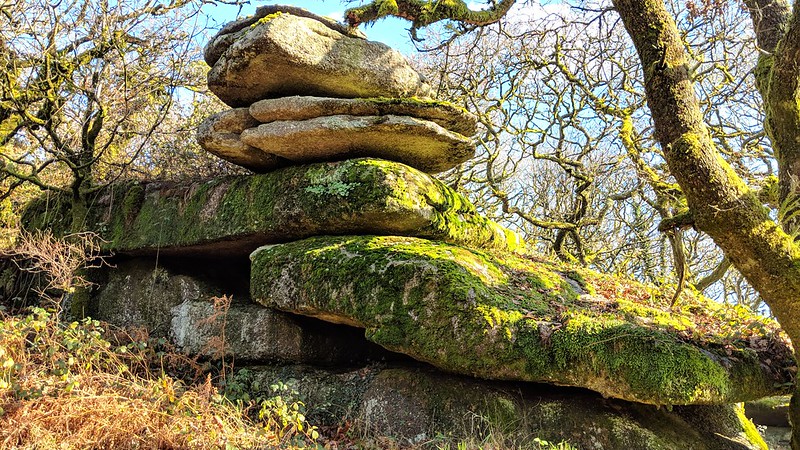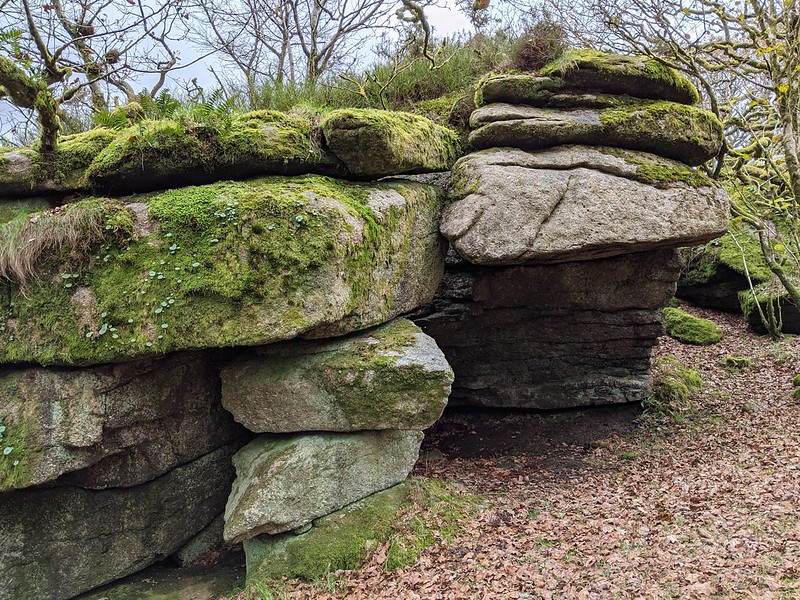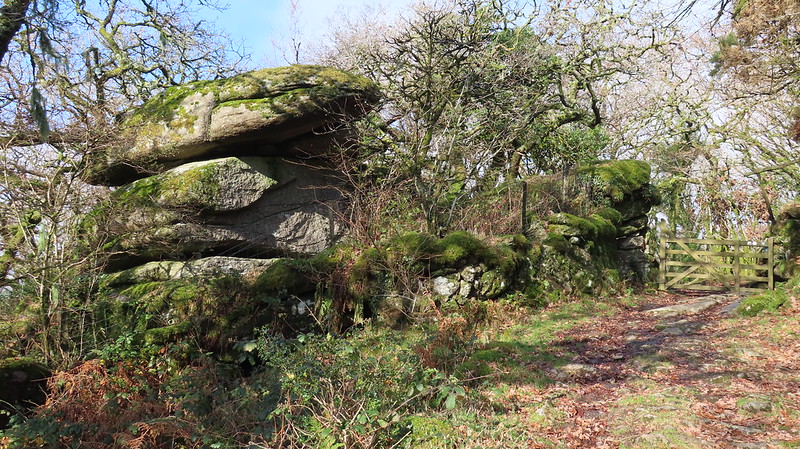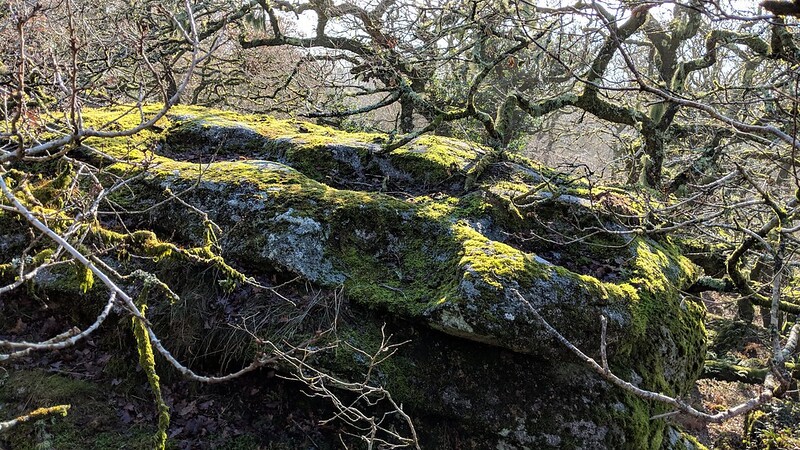TORS OF DARTMOOR
a database of both lesser- & well-known rocks and outcrops
Hucken TorOkel Tor, Okal Tor, Hook-in-the-Tor, Tor-in-the-Oaks, Wood-in-the-Tor, Hulkyntor, Oaken Tor, Oak Tor, H'woaken Tor
 Walkham Country is one of the most beautiful and varied areas of Dartmoor. From its source up on the high moor, the river passes below the mountainous stacks of Great Mis Tor and Great Staple Tor to enter a magical glen, crowned on either sides by outcrops of some magnitude. The most famous of these, Vixen Tor, sits within a private enclosure high above the right bank, yet at an equal elevation and across the river there is Hucken Tor, a simply magnificent tor that warrants an extensive exploration. As a considerably sized tor that is situated on the edge of the moor to the south of Merrivale that has outcrops both on moorland and in vibrant woodland, it is difficult to know where to begin when describing this huge concentration of ruined granite, but it is the section within trees that holds most who visit spellbound and this is a firm favourite for many tor baggers.  When approaching from Merrivale via Longash Farm, the rambler passes between a succession of enclosures before crossing the Pila (or Longash) Brook on what is known locally as Little Wonder Bridge. This public bridleway leads into an ancient oak woodland and around the next corner the first rocks of Hucken Tor appear. As the visitor approaches, they find themselves left in awe at the combination of moss and plants that cling onto the granite interspersed with oak, and further along this track, further outcrops appear as rugged walls like a ruined bastion. Soon a gate appears wedged between two huge stacks and the right (and lower) of these at SX 5478 7382 is crowned by four rock basins that are marked on Ordnance Survey Maps, one of these not capable of holding water as the edge of the basin has succumbed to the brutal weathering that the tor would have seen prior to afforestation. Hemery (1983) attempts to explain the derivation of the name as being attributed to a gate in the vicinity: "The prima facie etymology of the name seems so convincing: the undoubted presence of oaks here for untold centuries suggests a mutation such as 'Oak Tor' - 'Oaken Tor' - 'H'woaken Tor' - 'Hucken Tor'." The author, however, then remarks that "the late Ern Cole of Long Ash always insisted that the name was a corruption of 'Hook-in-the-Tor', an ancient tradition so closely related to the medieval 'Holk' that there seems no room for the more academic derivation from 'Oak'." In a footnote he later says that the "gated entrance to the medieval enclosures on the north side of the tor is highly probable."  The shadowy masses of the tor, as if in perpetual twilight, are simply stunning and have led to successive Dartmoor writers to wax lyrical about the setting. Crossing (1905), after giving the local name of Okel Tor, states that "The scene presented as it comes into view is truly characteristic of the Dartmoor borders. The rude walls of small enclosures, encumbered with scattered granite, are seen on the hillside to the right; to the left is the valley, and beyond rise rocky peaks." Richard Horsham (2021) refers to Hucken Tor's dimensions as: "a spur-end tor 90m above the deeply incised River Walkham, and a projection of the spur extending from the King's Tor ridge. It covers an area of 150m x 130m on a steeply sloping surface and is formed of numerous large blocks of granite." As you leave the track and progress through the woodland, uphill, you soon come to a clearing that provides a most stunning backdrop of Vixen Tor's mighty eminence alongside the less impressive but still noticeable Heckwood and Feather Tors with Barn Hill Rocks nearby, behind which and further north is the much higher Cox Tor. Close to this opening in the woodland canopy, a small mossy rock basin can be seen at SX 54827 73912 and beyond it are yet more outcrops, some perched on slanted angles. Here, on the very edge of the woodland, a cave and overhang has formed in the elongated outcrop that allows for light to illuminate the otherwise dark crevice.  Strewn across the slopes southward are additional rocks, including at SX 54976 73765, each with their own character, tightly gripped with climbing plants and adorned in luxurious moss. Some of these create passages through which the explorer can feel a part of this romantic landscape by passing in between the granite. Above this the tor continues and the overwhelming sense of secludedness that has been so far experienced dwindles somewhat as, crossing a low, dilapidated wall, you emerge onto open moorland with the two King's (or King) Tors plainly visible above a newtake wall to the east. The final rock is a whale-shaped boulder at SX 54957 73837 that rests at an angle; and the small rock basins on its surface show that the rock never used to be tilted and was once in a flat position. Hucken Tor is an undeniably beautiful place that is rooted in the very oaks that find shelter here in this breathtaking landscape. For its charming natural beauty and historical setting, the rambler in their excursions on Dartmoor is urged to pay a visit to witness the relatively unchanged scenery of the tor that both Crossing and Hemery enjoyed in their travels of the early and late 20th Century respectively. You will not be disappointed.
| ||||||||||||||||||||||||||||